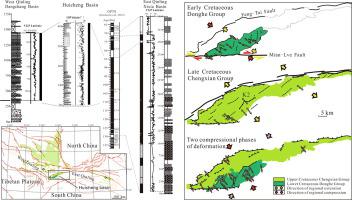当前位置:
X-MOL 学术
›
J. Asian Earth Sci.
›
论文详情
Our official English website, www.x-mol.net, welcomes your
feedback! (Note: you will need to create a separate account there.)
Post-orogenic tectonic evolution of the Qinling belt, central China: insights from a magnetostratigraphic study of a Cretaceous intra-mountain basin sedimentary succession
Journal of Asian Earth Sciences ( IF 2.7 ) Pub Date : 2020-10-01 , DOI: 10.1016/j.jseaes.2020.104496 Xuzhi Hu , Yueqiao Zhang , Yongxiang Li , Shouxian Ma , Junpeng Li
Journal of Asian Earth Sciences ( IF 2.7 ) Pub Date : 2020-10-01 , DOI: 10.1016/j.jseaes.2020.104496 Xuzhi Hu , Yueqiao Zhang , Yongxiang Li , Shouxian Ma , Junpeng Li

|
Abstract The Huicheng Basin straddling the west and east Qinling belt in central China is a key feature linking the NE Tibetan Plateau and the rifted basins in East China, and its sedimentary sequences provide important archives to elucidate tectonic evolution of the Qinling belt and possibly the eastward expansion of the Tibetan Plateau. The age of upper red fluvial-lacustrine facies sequence, known as the Chengxian Group, has been previously assigned to Neogene in spite of the lack of age-definitive fossils, which seems problematic. In order to better constrain the age of this Group and to establish a chronostratigraphic framework, we conducted a magnetostratigraphic study of about 420 m thick composite section and collected 738 paleomagnetic samples. Progressive thermal demagnetization of these samples reveals both single- and two-component magnetizations. Characteristic remanent magnetizations (ChRMs) are mostly isolated at or above 350℃ and show northeasterly downward directions, indicating unanimously normal polarities through the composite section. Positive fold and tilting tests suggest that the ChRMs are likely primary and that this sequence was possibly deposited during the Cretaceous Normal Superchron, instead of the previously assigned Neogene. By correlating with other Cretaceous basins developed in west and east Qinling and taking into account the polyphase tectonic overprints from structural analysis, we conclude that the Huicheng Basin was formed during the post-orogenic tectonic regime in response to far-field effects caused by the northward subduction of the Neo-Tethys Ocean and the subsequent India-Eurasia collision.
更新日期:2020-10-01











































 京公网安备 11010802027423号
京公网安备 11010802027423号